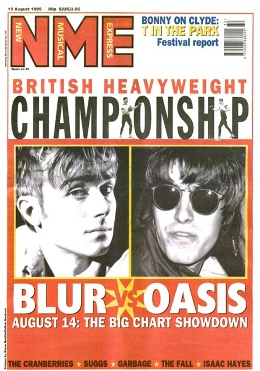Background and Ownership
NME was first published 7th March 1952, and from that day onwards has been a popular weekly music magazine. NME was at it's prime in the 1970s as it became the best-selling British music magazine. This magazine is also closely related with the Punk/Rock genre, and to this day still features new and upcoming bands of this particular genre of music. From, the start of the 1990s, NME included more and more Indie/Alternative bands in the magazines.
NME is owned by IPC Media, a company also producing books, newspapers and new technology. NME has a website, created in 1996 supplementing what is displayed in the music magazine. The website is updated weekly presenting news, information and pictures of what you may find in the magazine but also other aspects too. For example, in 2001, to encourage people to visit the website and promote bands, the NME website gave away a free download of "The Strokes" debut single "Last Nite" a week before it was originally released. Not only does this help promote the band as it gives the listener an insight into what their music sounds like, but it encourages music fans to visit this site frequently as there maybe more singles to download, typically of their music taste. Additionally, in 2007, NME TV first hit our screens, producing coverage of the type of bands displayed in the magazine. Similarly, in 2008, NME Radio was first released, broadcasting new Indie/alternative tracks corresponding with the magazine. There is also NME Awards and Tours which feature some of the biggest names in the Indie Music industry.
Reader Profile
The average age of a NME reader is 23, with 65% of readers of the male gender. In May 2008, NME redesigned their magazines, hoping to appeal to a more older, sophisticated audience, losing the "poppy" aspect. It would seem that the readers of NME display a keen interest in fashion as it could be argued that they use their favourite bands/artists as fashion icons. The posters featured in the magazine display full length posters of well-dressed bands, perhaps hoping to influence the readers. Also, the band merchandise displayed in the weekly issues reinforces the love of fashion. Additionally, according to market research, the NME reader regularly downloads new music weekly, the enthusiasm of the readers is displayed in the magazine as it regularly features many dates for gigs, album reviews and gig reviews. Additionally, NME releases special editions for Glastonbury and Reading & Leeds Festivals, as well as having an NME stage at these particular festivals.
Style/Layout/Mode of Address
Originally, NME was published in a non-glossy tabloid format on standard newsprint, simliar to a newspaper. For example:
February 1976
August 1996However, from March 1998, the paper was no longer published on newsprint but it was printed in a tabloid size and possesses a full, glossy front cover which gives a more modern appeal. At this present time the NME costs £2.30 (2010), but over the years the price has risen as it is costing more to publish. This prices is still reasonably cheap as it is catering for the younger generation's finances, often the magazine includes free CD's or posters for the reader to collect. Each week there is a different image displayed on the front cover of the music magazine which generally covers most of the page, a block of text usually supplements this informing the audience of the purpose of this picture. Inside the magazine, there are pages devoted to various bands/artists, dates of gigs and tours, band clothing available to purchase and posters. The posters demonstrate the youth readership.
To display the conventions of Indie/Alternative music, NME features puns in titles relating back to music, for instance, there is a section about "The Drums", and NME refers to them as "the surf-poppers" which evidently relates to one of their songs. This shows the audience that this magazine is purely for dedicated music fans as they would be the readers than understand the pun. There is use of slang and words such as "emo" referring to groups of people, illustrating that the target audience is the late teens as this type of language appeals to that particular age group.
Content and Approach to Music
This magazine is related with less popular Indie music and does not focus on mainstream Pop Music. This is an advantage for small, young, unsigned bands as it helps them promote thereselves. Also, this is another aspect for young, enthuastic, festival "go-er's" as it allows them to keep up to date with the latest music that an average person may not be aware of until a few months later when it is shown on TV. The majority of the content in NME is articles, interviews and tour information on less mainstream Indie/Alternative bands such as, The Drums, Crystal Castles, Arctic Monkeys, Vampire Weekend, British Sea Power, The Cure, Morrissey and many more... Many of which have been supported from the early days of their careers by NME.
Throughout the magazine, the NME magazine directly addresses the audience which engages them to read more and would perhaps make them feel part of the magazine itself. For example, the magazine states "what you thought" and also states "we" in headings. There is a fan page where readers can share their thoughts about recent gig experiences, ask questions and generally give their opinions on music.



No comments:
Post a Comment